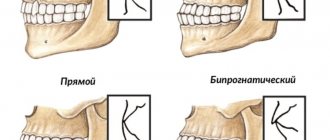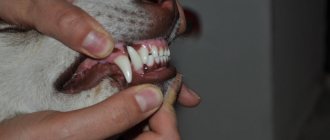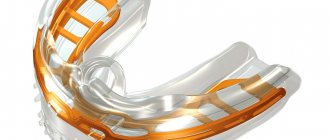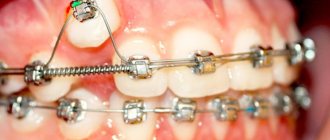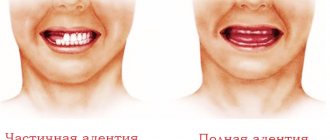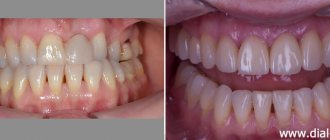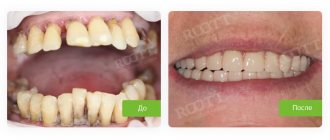Are you drafted into the army with an incorrect bite? We will help you! Malocclusion is one of the diagnoses that gives the right to a deferment or complete exemption from the army. This anomaly has several degrees of severity. They are not called up only for serious deviations, the presence of which is confirmed by medical reports. To find out whether people with an incorrect bite are accepted into the army and what fitness categories are assigned to conscripts, we advise you to study the “Schedule of Diseases”.
Article 56 is devoted to maxillofacial pathologies, where clear answers are given regarding the current restrictions.
Types of malocclusion
Before dealing with the necessary corrections of bite in children and adults, it is necessary to establish what type of problem it belongs to:
- Mesial - the lower jaw protrudes noticeably forward. The reason is its greater development than the development of the upper jaw. The chin is pushed forward. Complaints of cracking joints and headaches are possible. Often, surgery is not possible in this case, but sometimes it is possible to use standard braces.
- Deep - the upper jaw “blocks” the lower jaw. As a result, problems with speech and chewing food occur. A surgical plastic procedure to correct a deep bite or with the help of braces is possible.
- Distal - the difference between deep and distal violations lies in the enhanced defects of the upper jaw, which almost completely covers the lower jaw. To resolve this malocclusion condition, trainers are used to gradually “train” the jaws to achieve proper function.
- Crossed - the jaw is shifted either to the left or to the right. In addition, the teeth themselves move horizontally, and the jaw is narrowed. Such problems in the jaw apparatus are possible due to complications in the replacement of baby teeth and growth disorders. The cause is also listed as a hereditary factor and periodic inflammation of the ears.
- Open - the two jaws do not close because the individual teeth simply cannot meet. This often appears in the front part of the teeth due to the fact that the child has been sucking pacifiers or fingers for a long time. Rickets may also be the cause of this defect. First, treatment is carried out to establish the underlying causes of the defect, and only then does it move on to the stage of selecting structures for correction. In this situation, slings with rubber rods or spring-based expansion plates are often used.
How the face changes due to impaired jaw closure
Malocclusions carry a pronounced cosmetic defect
. This is an unattractive smile, changes in facial proportions, for example, a too protruding lower jaw, a constantly slightly open mouth. A massive, heavy chin also does not add attractiveness to the face, because it makes the jaw look much larger.
Photo 3. A woman’s face in profile with a malocclusion (left) and after correction of the pathology (right).
The appearance of gaps between the lateral dental sections causes facial asymmetry and the effect of “sunken cheeks”
as if the lateral teeth were completely absent. To all this you can add a somewhat confused and surprised-stupid expression on the face, which does not suit the person at all.
Of course, an incorrect bite changes the face and asymmetry appears. This happens because the teeth on one side wear away faster. With age, this problem only increases.
How to correct an overbite
An incorrect bite is not only an external defect, but also the basis for future problems with teeth and digestion. To avoid this kind of trouble, it is recommended to correct your bite. At home, bite correction is possible using the following methods:
- Orthodontic plates are special removable plates that can secure teeth in the desired position. Most often they are prescribed to children under 12 years of age. They are removed during meals and during sanitary and hygienic procedures in the oral cavity. The plates are made for each child individually after the procedure of taking impressions of the jaw. The outer part of the plates consists of a wire that holds the teeth from protruding forward, the inner part prevents the teeth from “going” back and is adjacent to the gums.
- Braces are special non-removable systems. This is a surgical solution to the problem of the jaw apparatus, which is associated with great inconvenience during their use. The advantage of such orthodontic systems is that their level of impact is much higher than that of plates. The disadvantages are that getting used to braces takes more than a few weeks. In addition, difficulties begin with maintaining oral hygiene, which entails an increased risk of caries.
- Orthodontic trainers are one of the latest and newest methods of teeth correction in modern medicine. The basis is not hard, but soft plates that can correct speech defects, difficulties with swallowing and incorrect placement of the tongue in the mouth. A person puts on trainers for a couple of hours a day and reinserts them just before bed. Unlike ordinary plates, trainers can be worn not only by children, but also by adults. In addition, they remove bad habits from the child.
- Myotherapy is a set of exercises aimed at correcting the jaws and facial muscles. It has proven itself most effective in young children with malocclusion problems. Most often, parental control over the implementation of exercises is required, as this requires some effort from the child. Myotherapy loads the floor of the mouth and muscles in order to develop the jaw bones in children. Completing all the necessary exercises from the complex will reduce the risk of malocclusion in the future. This will become the basis for the proper growth of permanent teeth.
- Surgical correction of bite — this procedure is more often used in difficult cases when it is impossible to achieve a normal bite using standard methods. The following types of bite correction surgery can be distinguished:
- Maxillary osteotomy. Doctors move the upper jaw along with the teeth and palate. After the operation, they will fix the jaw using the necessary splint.
- Mandibular osteotomy. An incision is made into the bone tissue, then the jaw itself is displaced and fixed with titanium plates. They will be removed when the bone grows in the required quantities in the postoperative position.
- Aesthetic genioplasty. Facial symmetry is corrected. The operation is based on the correct placement of the chin exactly along the midline.
Please note that the procedure for correcting malocclusion inevitably involves the intervention of an experienced dental surgeon.
You can find out more about this procedure and its cost in our section “Bite correction.” MAKE AN APPOINTMENT
Useful tips
Doctors recommend correcting bite defects as early as possible. In childhood, the root system is very mobile, so the teeth move easily. Accordingly, correction takes a shorter period than during treatment in adulthood.
Young men should plan to correct malocclusions, taking into account the possibility of conscription for military service. The best option would be to contact an orthodontist long before adulthood.
Wearing braces for each patient proceeds individually, depending on the characteristics of the body.
When undergoing service with braces, some complications may arise, which are quite difficult to correct:
- Poor digestion;
- Abrasion and damage to enamel;
- Inflammation of the gums;
- Increased tooth sensitivity;
- Impaired diction;
- Distortion of facial features.
If the above violations occur, immediate assistance from an orthodontist is required.
Types of bracket systems
The existence of a wide variety of brace systems is explained by the fact that for many people wearing them has become not only of a health-improving nature. If a person wears braces for a long time and wants to look decent at the same time, then he may have a desire to purchase visually more beautiful models:
- Plastic ones are affordable for most patients, but the low cost comes at the cost of fragility. Best suited for treating mild bite problems for a short period of time.
- Metal braces are one of the most common correction methods due to their low cost and effectiveness. The metal is durable and easy to clean.
- Ceramic braces are gaining popularity due to the fact that plates of the right color can be almost invisible to the eye. “Ceramics” does not change color over time, practically does not cause allergies, and in terms of strength it is slightly less than metal.
- Sapphire braces are based on single crystals of an artificial mineral. They have a transparent appearance, are practically invisible to others, and require careful handling since they are more fragile, unlike their metal and ceramic counterparts.
- Lingual braces - the high price is compensated by their complete invisibility to others. They are placed on the inside of the teeth so as not to show signs of treatment of the jaw apparatus. These braces are made of gold and metal, which also justifies the cost.
Who is considered fit for service?
According to the degree of health suitability for military service, there are categories:
- "A".
- "B".
- "IN".
- "G".
- "D".
What category you have will be determined by the military medical commission when you undergo a medical examination. Group “B” is called up, but group “C” is not. Some fairly healthy young people want to break the law and want to be assigned category “B” and released from service.
Before passing a special medical examination, it is best for you to visit doctors and ask how healthy you are, are you subject to compulsory conscription or not? All categories except the last “D” are subject to change.
For example, at the time of conscription your arm was broken and you received category “G”. After 2 months the bones will heal during a second medical examination after 6 months. and moreover, you feel great. You may be given category “A” or “B” and taken to serve in the army.
Categories
Let's take a closer look at the categories:
- "A" is good health. Fit for military service.
- “B” health is normal, but there are some limitations. Detected deficiencies do not prevent you from serving. For example, myopia is slight.
If you have category “B”, then it is customary to specify: “B-1” or “B-2”, which means “B-3”, etc. 1, the most that the restrictions are less than with 3. Conscript with “B” will not be hired to serve in the navy or as a paratrooper. They recruit strong young men there.
- Your “B” is fit for service, but with restrictions. In fact, experts believe that he is not fit to have serious health problems. You will not be drafted, but will be enlisted honorably in the reserve.
- “G”, it is believed that the young man is currently (temporarily) serious about serving, and later, when he recovers, for example, from an injury of varying severity, the military registration and enlistment office will send him a summons. There will be a chance in 6 months. or 1 year to enter the service.
- “D” Thus, he is definitely unfit to serve. There will be no re-examination.
How to correct an overbite without braces
Yes it is possible. Correcting the bite of adults without braces is possible, just like for children. There are many designs that correct these pathologies.
- Aligners (or Aligners) are similar in appearance to a transparent hollow jaw. The main advantage is visible results in a short period of time. They are easy to care for; the mouth guards can be easily removed and put on. First, an impression of the dentition is taken, then as use progresses, a certain number of trays are made. Gradually, the bite changes and a new mouthguard replaces the previous one on the way to the final result.
- Trainers are a special elastic silicone splint that adapts to the jaws. It is easy to chew and provokes allergic reactions. The splint is worn for several hours a day and put on during sleep, does not interfere or create discomfort. The use of trainers aims to eliminate the causes that lead to malocclusion. They do not have a strong impact on the dentition and smoothly give the bite the correct shape.
- Veneers are small prosthetics that are placed on the outer surface of the teeth, adding visually desired color and shape. In addition, veneers correct bite and crooked teeth. Dentures are thin (up to 0.6 mm), durable, strong, enhance the visual attractiveness and evenness of teeth. When smiling or talking, it is impossible to distinguish from natural ones.
- Crowns are non-removable structures of a special shape that are needed for dental prosthetics. Thus, crowns hide damaged tooth elements or fillings. In addition, this product serves as an anchor for a dental bridge. If a patient needs to have a permanent crown installed, he or she will have to visit the dentist several times. After installation, continue to maintain oral hygiene as the installation of crowns does not eliminate the risk of caries.
- Plates hold teeth in the desired position and correct malocclusion. A person can put on and take off the plates himself. Most often they are prescribed for children, but use by adults is also possible, although only in cases of minimal dental defects.
Anomaly of 2 degrees with separation of 5-10 mm
According to Art. 56 Schedules of diseases, item “b”, fitness category “B” is assigned for defects of the lower jaw, the presence of transplants after surgery. Pre-conscription conscripts upon initial registration with the military registration and enlistment office are considered to be of limited fitness - category "G" if less than 6 months have passed since the operation.
In case of malocclusion of the II degree with a separation from 5 to 10 mm with a chewing efficiency of less than 60%, in case of an malocclusion of the II, III degree with a separation of the bite of more than 10 mm (without taking into account the chewing efficiency), suitability category “B” is assigned. In case of malocclusion of the II degree with separation from 5 to 10 mm with a chewing efficiency of 60% or more percent - “B”.
For those examined with non-removed metal structures after osteosynthesis of fractures of the maxillary bone and (or) mandible with minor or no impairment of respiratory, olfactory, chewing, swallowing and speech functions, paragraph “B” applies.
If there is a malocclusion of the first degree, a displacement of the dentition by less than 5 mm, the conscript is drafted into the army.
Causes of malocclusion in children and adults
Anomalies in adults come straight from childhood. This once again confirms the need for parents to closely monitor their children’s teeth. In children, malocclusion is formed due to heredity, the habit of sucking a finger or pacifier, pathologies in the mother during pregnancy, diabetes mellitus or low consumption of solid foods. In adults, in addition to causes from childhood, the anomaly can cause jaw injuries, lack of calcium and fluoride, unsuccessful dental prosthetics, malnutrition and metabolic processes.
Reviews
Dear readers, you can leave your feedback on whether people with an incorrect bite are accepted into the army in the comments, your opinion will be useful to other users of the site!
Andrey
“Theoretically, we can do everything, practically nothing. You still need to be able to prove an incorrect bite. They are sent to the army with major defects.”
Oleg
“I got braces shortly before the commission at the military registration and enlistment office, I thought it would help me get a deferment. No, they said, take it off and go ahead and serve.”
